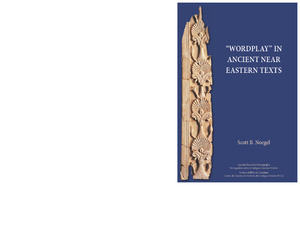Por favor, use este identificador para citar o enlazar este ítem:
https://repositorio.uca.edu.ar/handle/123456789/11864| Campo DC | Valor | Lengua/Idioma |
|---|---|---|
| dc.contributor.author | Noegel, Scott B. | es |
| dc.date.accessioned | 2021-07-14T23:57:29Z | - |
| dc.date.available | 2021-07-14T23:57:29Z | - |
| dc.date.issued | 2021 | - |
| dc.identifier.citation | Noegel, S. B. "Wordplay" in Ancient Near Eastern texts [en línea]. Ancient Near East Monographs - Monografías sobre el Antiguo Cercano Oriente, Vol. 26. Atlanta : Society of Biblical Literature; Centro de Estudios de Historia del Antiguo Oriente, 2021. Disponible en: https://repositorio.uca.edu.ar/handle/123456789/11864 | es |
| dc.identifier.uri | https://repositorio.uca.edu.ar/handle/123456789/11864 | - |
| dc.description.abstract | Abstract: This book has three intersecting goals. First, it aims to provide the tools necessary for a comparative, in-depth study of “wordplay” in ancient Near Eastern texts. Second, it aspires to establish comprehensive taxonomies for the many kinds of devices that scholars have labeled as “wordplay” and for their proposed functions. Finally, it seeks to establish a consistent terminology that will offer students and scholars of ancient Near Eastern languages a useful template for documenting and understanding the devices they discover, and scholars of other disciplines access to the sophisticated devices of ancient Near Eastern writers. This, I hope, will lead to greater precision and interdisciplinary dialogue. The astute reader will notice that I have placed the term “wordplay” in quotation marks. It is my contention that the term is problematic for many reasons, which I discuss in chapter 1. Nevertheless, I find it heuristically useful in communicating to those outside the discipline what sorts of devices this book will examine, even if the devices differ in technique and their functions and social contexts appear alien. Readers also will note that I have opted to use the word texts, in the title rather than literature. There are two reasons for this. First, one finds “wordplay” in texts of all kinds, including annals, letters, law codes, medical prescriptions, omen lists, and ritual descriptions. In fact, there appear to be no generic or chronological restrictions to the application of “wordplay” in the ancient Near East. A second reason is that the social background of textual production, which I discuss in the chapter 2, strongly suggests that many forms of “wordplay” have an illocutionary function. Thus “wordplay” is often as much a performative phenomenon as a literary one. It is rather ironic that the presence of “wordplay” in ancient Near Eastern texts has been recognized for many years—in the case of the Hebrew Bible, for several centuries. Yet, large-scale publications on the phenomenon are rare. In addition, though we have benefitted from numerous articles on the subject, most have focused on select biblical passages rather than books. Moreover, until recently, most scholars were content merely to illustrate examples without discussing their functions, generic environments, or literary and social contexts. Consequently, despite the long-standing recognition, it is fair to say that many aspects of “wordplay” in ancient Near Eastern texts remain largely unexplored. Moreover, the disciplines represented in this study have long suffered from a vague, inconsistent, and, at times, even contradictory vocabulary that has done little to advance the study of the phenomena and all their permutations and effects. Consequently, many publications employ only the most basic terms for a number of devices that deserve individual attention. Thus, we find studies on alliteration that more accurately contain cases of homoeopropheron, homoioteleuton, parasonance, and the like, and publications on punning that ignore the visual register and do not distinguish devices of sound from those of meaning. It is my hope that this monograph will provide tools for advancing the comparative study of these phenomena with greater accuracy. | es |
| dc.format | application/pdf | es |
| dc.language.iso | eng | es |
| dc.publisher | Society of Biblical Literature | es |
| dc.publisher | Pontificia Universidad Católica Argentina. Centro de Estudios de Historia de Antiguo Oriente | es |
| dc.rights | Acceso abierto | * |
| dc.rights.uri | http://creativecommons.org/licenses/by-nc-sa/4.0/ | * |
| dc.source | Ancient Near East Monographs - Monografías sobre el Antiguo Cercano Oriente, Vol. 26. Atlanta : Society of Biblical Literature; Centro de Estudios de Historia del Antiguo Oriente, 2021 | es |
| dc.subject | ORIENTE ANTIGUO | es |
| dc.subject | LENGUAS ACADIAS | es |
| dc.subject | GRAMATICA | es |
| dc.subject | TAXONOMIA | es |
| dc.subject | ESCRITURA | es |
| dc.subject | LENGUA HEBREA | es |
| dc.title | "Wordplay" in Ancient Near Eastern texts | es |
| dc.type | Libro | es |
| uca.disciplina | HISTORIA | es |
| uca.issnrd | 1 | es |
| uca.affiliation | Fil: Noegel, Scott B. University of Washington. Department of Near Eastern Languages and Civilization; Estados Unidos | es |
| uca.version | publishedVersion | es |
| item.fulltext | With Fulltext | - |
| item.grantfulltext | open | - |
| item.languageiso639-1 | en | - |
| Aparece en las colecciones: | Series monográficas | |
Ficheros en este ítem:
| Fichero | Descripción | Tamaño | Formato | |
|---|---|---|---|---|
| wordplay-ancient-near-eastern.pdf | 9,97 MB | Adobe PDF |  Visualizar/Abrir |
Visualizaciones de página(s)
260
comprobado en 30-abr-2024
Descarga(s)
1.539
comprobado en 30-abr-2024
Google ScholarTM
Ver en Google Scholar
Este ítem está sujeto a una Licencia Creative Commons

